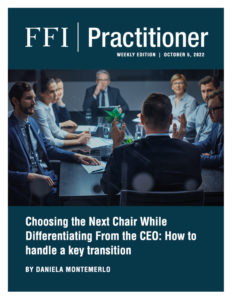
View this edition in our enhanced digital edition format with supporting visual insight and information.
In this week’s FFI Practitioner, Daniela Montemerlo explores the important role of the board chair in a family enterprise and explains the benefits of appointing two different people to serve as chair and CEO.
In governance literature, a common recommendation is to overcome “duality,” i.e., eventually to appoint two different people to serve as chair and CEO. This recommendation is often neglected in family firms, whose owner-managers tend to favor a high concentration of tasks and powers. A topic that deserves increased attention is the relevance of the chair for family business continuity and success. This article explores the reasons behind such relevance and the consequent need for more owning families to design corporate governance systems that incorporate a full-time chair. It also identifies three options to make the transition, highlighting special benefits and success conditions. Finally, the article offers tips for family business advisors to support this transition for their clients in its various phases.
The Chair is an Important Role That Can No Longer Be Neglected
While the board chair is not an executive role and tends to command less attention than the CEO, the chair’s responsibilities include fundamental tasks that make it among the most important positions in the company. The chair is often the first representative of the company from both a legal and a symbolic point of view, and he or she is also charged with leading the board of directors, overseeing the board’s design, organization, functioning, and change processes. The chair is the link between the company and its shareholders.
To complicate matters, the chair’s tasks are often conflated with executive ones. According to a survey conducted by SDA Bocconi School of Management’s Corporate Governance LAB,1 since 2020, nearly 55% of family firms with over €100 million in turnover have an executive chair. In about 20% of these cases, the chair/CEO is the only executive. In those cases where the same person occupies both the CEO role and the chair role, management-related tasks tend to take priority, reducing the chair’s capacity to make an impact through the board.

However, we live in a time of increasing complexity that emphasizes the need for effective chairs; we can view this need from three perspectives:
- Strategic complexity requires chairs to work alongside CEOs to offer advice, to guarantee accountability, to keep cooperative relationships with key stakeholders, and to create new relationships to enrich the company’s social capital.
- Ownership complexity demands chairs have ongoing dialogue with family shareholders of all generations, to facilitate communications among them, to be ready to cope with conflicts, and to take care of future shareholders’ education. When equity is opened to non-family shareholders, chairs are a key reference point for them and for their representatives on the board.
- Committed chairs, with their focus on the long-term success of the enterprise, are needed to help plan and manage leadership succession, coping with potential resistance, making the right choices, and fostering both legitimization and monitoring of new leaders.
The more the complexities apply to the enterprise, the more important it is for the chair to be a full-time job.
How to Move to a Full-Time Chair: Three options at a glance
Option 1: The most “natural” option may be for the present chair/CEO becomes the first full-time board chair, and a new leader is selected to take over as CEO. If all is properly planned and executed, this option provides the company with a powerful team composed of a chair with the wisdom, experience, and relationships to perform the role well, and a CEO who has the skills and the energy to lead the company. This model can strengthen leadership and governance with benefits for the entire family business system; particularly, “moving up” to the role of chair may be a positive step for former dual leaders. I have heard many new chairs describe how much they feared the transition but ultimately felt enthusiastic about their new role, as they could finally devote themselves to more strategic, fulfilling tasks. Sometimes they even regretted not having made the transition earlier. Of course, this transition can—and should—be gradual, with the ex-CEO not delegating powers all at once. For this option to work, regular communication between the CEO and the chair is a must, as is a CEO who takes special care to keep the chair updated.
Option 2: A second option is to appoint a non-executive chair of the same generation as the CEO, either when a new CEO is appointed, or once the new CEO is established in the role. The transition is often accompanied, and made possible, by the decision of the previous generation’s chair to step down, perhaps to serve as the chair of a family holding company or as an honorary chair. For this option to work, the incoming board chair must have sufficient authority to carry out his/her role without staying in the shadow of the CEO. The CEO, in turn, must respect and support the chair and ensure collaboration of the management team-to-board processes.
Option 3: A third option is to appoint a non-executive, non-family chair. This option can work well when there is a lack of consensus around one family member as the candidate, especially when conflicts arise during the selection process. For this option to be successful, it is especially crucial that the new chair has the trust of the owning family and fully understands and commits to the responsibilities of the position.
Of course, the effectiveness of each option depends on the family and the enterprises involved. In addition, some family enterprises may need solutions that cater more specifically to their situations, e.g., appointment of a chair and a vice-chair (one focused on relations with family owners, the other on relations with present and potential external stakeholders) or more than one chair in the case of large groups.

How to Make the Right Choice: Some tips for advisors and their clients
Behind every good corporate governance design is a process that is itself the result of other choices rooted in the family’s culture and ownership governance. To effectively prepare client families to overcome leadership duality, advisors can provide guidance in the following ways:
- Do not neglect the importance of the chair when discussing business leadership roles.
- Design an effective board and open it to capable and motivated non-executive and, particularly, outside directors. They will facilitate transitions.
- Carefully evaluate potential chair’s skills and aptitudes as well as their fit with the CEO, and discuss openly with the candidates both the positive aspects of the company and the challenges that the chair would need to address.
- Design tasks and powers that make the chair and the CEO roles a complementary duo, avoiding overlaps.
- Help the chair and the CEO regularly and properly interact with each other, understanding each other’s points of view and openly addressing critical issues.
- Set up proper information flows for the board with the active involvement of top management.
These processes require even greater care when co-CEOs are appointed instead of one CEO. In such cases, an additional, sometimes delicate task of the chair is to ensure the co-leaders have a functional and collaborative working relationship and, if this relationship proves contentious, to help address and resolve these issues.
Whatever the chosen leadership model, family enterprises that strive for multigenerational success often benefit from dividing the CEO and chair roles and establishing practices and processes that help to ensure that both roles will be performed at a high level.
Reference
1Montemerlo, D., & Minichilli, A. (2020) Family business e nuove leadership (Family business and new leadership models). Economia & Management, 1, 65-69. https://emplus.egeaonline.it/it/61/archivio-rivista/rivista/3444825/articolo/3444920
About the Contributor

Daniela Montemerlo, PhD, is full professor of management and family business at the University of Insubria, affiliate professor of family business, strategy, and governance at SDA Bocconi School of Management, and professor of family business at Bocconi University. Her topics of special interest include family and corporate governance, family and ownership agreements, and next-gen development. Daniela currently chairs the FFI Achievement Awards committee. She can be reached at daniela.montemerlo@gmail.com.

View this edition in our enhanced digital edition format with supporting visual insight and information.





